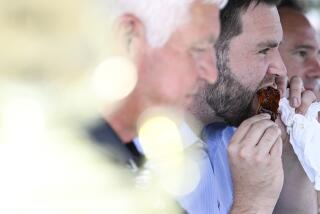Net Nanny
- Share via
In the 1970s and ‘80s, Ellen Haas was a firebrand consumer activist. In the ‘90s, she was a controversial Clinton appointee to the Department of Agriculture who went to battle on behalf of improved nutritional guidelines for school lunches. Today, she has transformed herself again, this time into a cookbook author, fitness expert and e-grocer.
If it sounds as if the woman once decried as the “nation’s nanny” has given up trying to reform us, there is no such reprieve. Haas is still keen to save us from ourselves, except that this time it may just make her rich.
The new business is fitness. Given this, it doesn’t hurt that at 60, Haas looks 40--if that. She is, as a 1994 newspaper profile drools: “Slim, fit and the same weight as at Forest Hills High School in New York City.”
In fact, she is in such good trim that it is borderline annoying. But then, I would say that. I have recently had my own fitness assessed by Haas’ new Web site FoodFit.com (https://www.foodfit.com).
Submitting to the inquisition about weight, age, diet and lifestyle takes only minutes. It is dealing with the results that can take longer. My profile estimates that it will take me 32 weeks to reach the weight that I was in high school.
It even takes it upon itself to rank my overall fitness, giving me a 60 out of a possible 100.
“Oh dear,” gasps Haas when I tell her. But she quickly regroups with funny stories about people trading equally lousy scores at cocktail parties in Washington, D.C. “People were hysterically laughing,” she says.
Naturally, Haas took her own quiz, but initially she claims that she can’t quite remember what score she got. “It was either an 80 or a 90,” she finally admits.
Ten bucks says it was 90.
One would think that most 90s would be content to preen. But Haas wants us all to score 90s. “I’ve always believed in the importance of healthy eating and being active and how much fun it could be,” she says. So, the woman who is a strong believer in “portion control” and who gets to a gym at 7:30 in the morning four times a week would like us to benefit from athletic regimens too.
On the Web site, the message about diet comes across through a carefully coordinated battery of tips. “Your fat intake may be too high,” my FoodFit profile speculates.
Alongside criticism, there is plenty of encouragement. “Congratulations!” it declares in another instance. “It looks like you’re getting enough fruits in your diet.”
This helpfulness is, of course, a prelude to selling us things. As FoodFit’s online shopping service activates later this month, the site will not just tell us that we could use fewer milkshakes and more smoothies, it will also offer deals on the mangoes and then on the blenders with which to whip them up.
The business potential of FoodFit seems as bottomless as a glutton. As Haas describes it, the site “has multiple revenue streams.”
Consider, for example, the branding possibilities. One day, Haas hopes, the FoodFit label will carry the same resonance as the Good Housekeeping Seal of Approval and may even outshine the internationally recognized stamp of her old outfit, the USDA. “We have been talking to a number of companies about co-branding a FoodFit line of products,” she says.
But can the road to riches really be paved with good intentions? The former consumer activist insists that FoodFit is indeed the logical conclusion of a campaigning career. “I’ve always been someone who wanted to make a difference,” she says. “And I think that the Internet and an Internet company that empowers the consumer is the best way to make that difference.”
There is no doubting Haas’ sincerity on that. She is every inch a Nader-era American.
Born in Queens, N.Y., Haas studied history in the radicalizing ‘60s at the University of Michigan. After working as a history teacher in Oklahoma City while her husband completed medical school there, she was by the early ‘70s living in the Maryland suburbs of Washington.
Her first political effort was to organize a consumer group of young mothers because, she says, “food prices were rising and food quality was going down.” This earned her a place, she says, in the 1973 edition of the Encyclopedia Britannica, where she was pictured picketing the Ford White House over the price of meat.
She went on to found and/or lead a succession of consumer and advocacy groups, including the Community Nutrition Institute, Public Voice for Food and Health Policy and the Consumer Federation of America. At these, Haas would battle for better seafood inspection and return to the theme of meat, this time trying to improve grading for the leaner and, she thinks, more healthful cuts.
But in 1993, one of the federal government’s most constant critics was suddenly absorbed by one of her regular targets. Clinton appointed Haas assistant secretary for food and consumer services.
She lasted only one term and says she won’t miss being “beaten up by Congress.” But she bridles at any suggestion that she was forced to leave.
“I never intended to stay more than a term,” she says. “I went in to accomplish three objectives. I changed the school lunch program to meet the dietary guidelines. I wanted to launch a nutrition education campaign, which I did. And I wanted to change the food stamp program to make it more of a nutrition program, and I did that.”
That California was the first state to reduce fat, salt and sugar content in school lunches is attributable not just to Haas but to the school district nutritionists and the network of star chefs she enlisted in the cause. Witness after witness appeared at public meetings decrying antiquated standards that had not been improved since the school lunch program began in the 1940s.
Today, these chefs remain loyal. Among those named as members of the FoodFit advisory board are Alice Waters, Mary Sue Milliken, Susan Feniger and John Ash. In return, Haas promotes the cooking of these chefs. The recipes on her site and in her new book, “Great Adventures in Food” (St. Martin’s Press, $25), come from them, along with contributions from other chefs across the country.
Allegiances from USDA days have also carried over. The public relations firm promoting FoodFit is run by Tony Podesta, brother of John Podesta, White House chief of staff.
When Haas has recruited medical expertise, she has gone for the best. FoodFit’s nutrition consultant is George Blackburn, associate director of nutrition at Harvard University Medical School.
The upside of all this gravitas is clear information on vitamins, minerals and nutritional guidelines. For example, the approval for my fruit intake came with the reminder, “Make sure you eat plenty of citrus fruits, melons and berries, which are excellent sources of vitamin C and antioxidants, which may prevent cancer and other diseases. Whole raw fruits are also good sources of fiber. For more on fruit, read our spring fruits guide.”
The downside is that Haas and Blackburn can reduce science to a brickbat to beat us with. They cite possible cancer “links” to low-fruit and high-fat consumption. Haas insists that the experimental data she has encountered is so compelling that it was “important for us to transfer this information.”
But no real information is “transferred.” It leaves one wondering what happened to the time-honored reason for promoting a balanced diet. This is far more compelling than the oft-exploited fear of cancer. It’s comfort.
But all in all, logging on to FoodFit.com is impressive. The tone is gung-ho happy camper as it tells you what to make for lunch and then how long you will need to swim to work it off.
Given the relentless mix of cheer and tips, the upshot can also be faintly hallucinatory, like entering a supermarket through the pages of a women’s magazine displayed at the checkout. Wandering from flank steak recipes to calorie charts to heart specialists to articles on baby gyms to tips on storing artichokes, one wonders: Is this a supermarket or Family Circle? A gym or a restaurant? A kitchen or a doctor’s office? A chef or a personal trainer?
FoodFit might be too chirpily helpful for some. But there is no doubting its zeal. Having registered with the site and been appraised as a 60 who should cut down on fat, I trigger a special low-fat cyber-minder every time I log on. It will help me find the things that will be best for me, be they recipes, exercise tips or groceries. Last time I looked, it was trying to interest me in a one-egg omelet.
“A zinger isn’t going to go off if you buy olive oil,” says Haas, laughing, “but at the same time the low-fat icon is going to follow you to give you positive advice.”
More to Read
Eat your way across L.A.
Get our weekly Tasting Notes newsletter for reviews, news and more.
You may occasionally receive promotional content from the Los Angeles Times.










